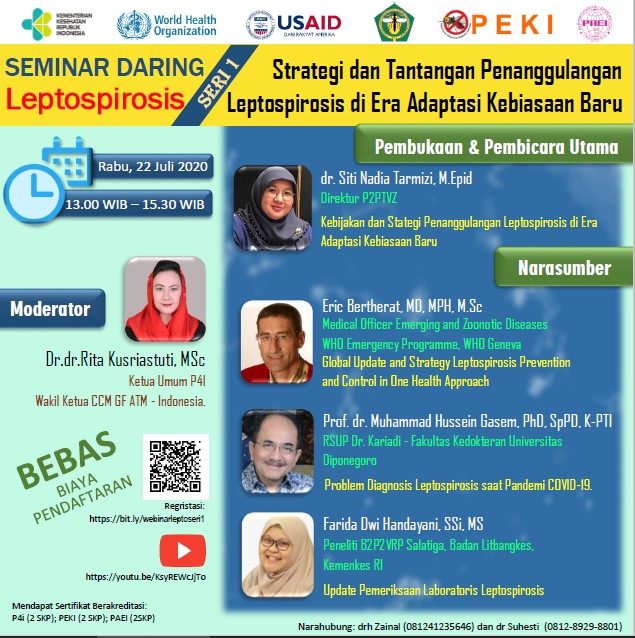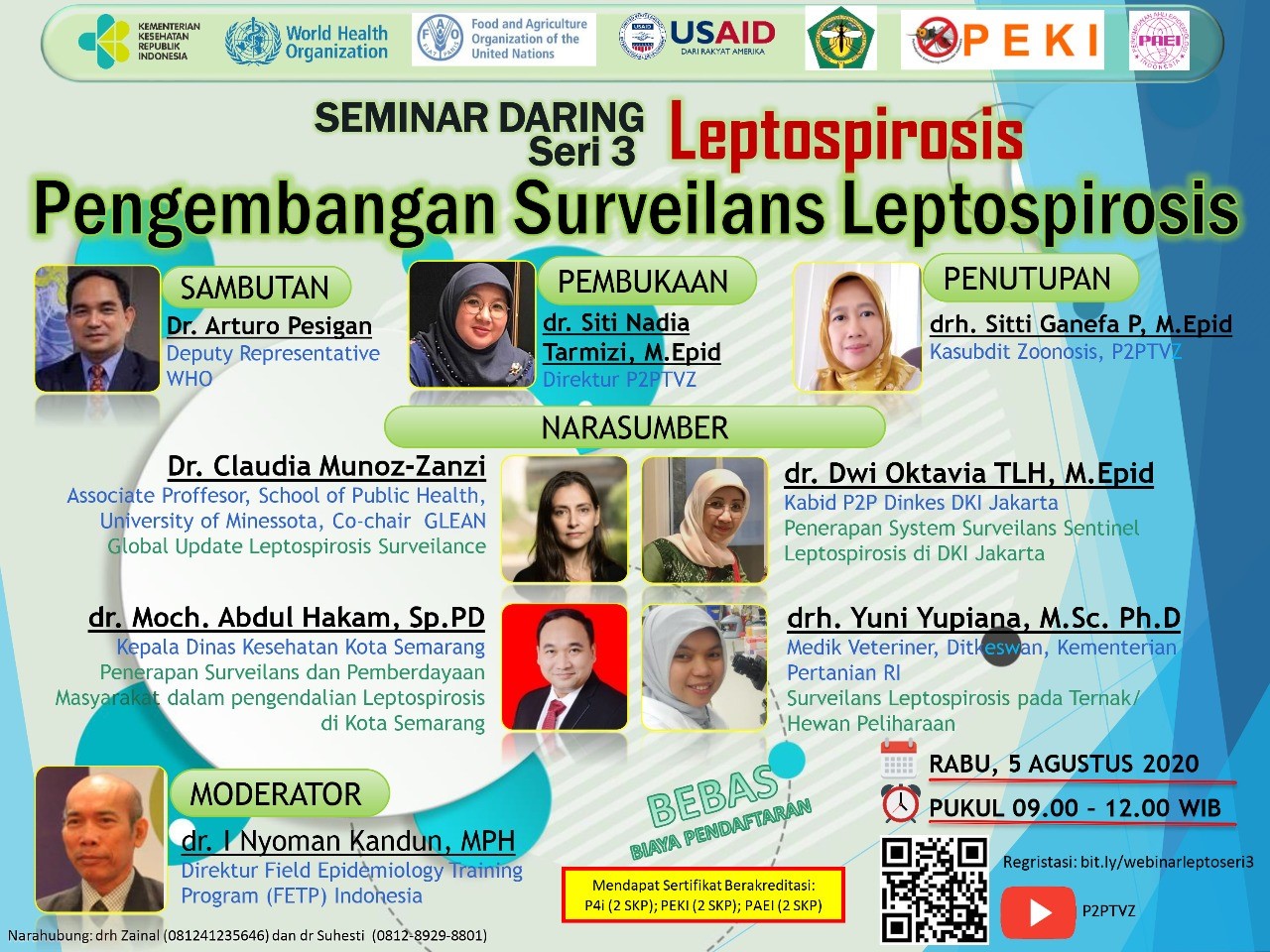Leptospirosis is a bacterial disease that affects both humans and animals. It is caused by a Leptospira bacteria most commonly contracted through the nose, mouth or eyes or through skin abrasions when a person is exposed to water contaminated by urine from infected animals. It occurs worldwide but is especially present in tropical and subtropical areas that experience heavy rainfall. The occurrence of leptospirosis is closely related to risk factors of infections.
In 2019, 920 leptospirosis cases were reported in Indonesia, with 122 deaths caused by the disease. The cases were reported from nine provinces (Banten, DKI Jakarta, West Java, Central Java, DI Yogyakarta, East Java, Maluku, South Sulawesi and North Kalimantan). However, this reported case number is a severe underestimate of leptospirosis occurrence in Indonesia given that the annual morbidity of leptospirosis in the population was recently estimated at 39.2 per 100 000 people.
Throughout July and August 2020, WHO collaborated with the Global Leptospirosis Environmental Action Network (GLEAN), Food and Agriculture Organization (FAO), Indonesia Epidemiology Association, Indonesia Entomology Association and Indonesia Parasitic Control Association to support the Ministry of Health host a series of four webinars on leptospirosis prevention and control in Indonesia. Approximately 4 000 participants from across the country attended the sessions to discuss relevant strategies and the application of the one health approach to address leptospirosis during the COVID-19 pandemic.
The first webinar, held on 22 July, focused on national policy on leptospirosis control in a ‘new normal’ era. The webinar highlighted the challenges of leptospirosis diagnosis during the COVID-19 pandemic. Early symptoms of leptospirosis may be similar with those of COVID-19, therefore, it is important for clinicians to be aware of the symptoms and risk factors for both diseases to enable prompt detection and appropriate treatment while still considering important infection prevention control measures. During the webinar, WHO presented global updates and the international strategy for leptospirosis prevention and control using the collaborative one health approach.

Leptospirosis Webinar Flyer. The first webinar focused on strategies for leptospirosis control during the ‘new normal’ era. Credit: MoH
On 29 July, the second webinar highlighted surveillance, ecology and control factors, with a specific focus on rodents as a mode of disease transmission. It also discussed updates to the global situation for leptospirosis prevention. An international expert from GLEAN presented leptospirosis epidemiology and examples from other countries of rodent surveillance and one health community-based control programmes implemented as part of leptospirosis control.
The third webinar was held on 5 August and explored the importance of leptospirosis control in animals as well as leptospirosis sentinel surveillance - including the experience of leptospirosis sentinel surveillance in DKI Jakarta and Semarang, Central Java. Strong surveillance systems are a key strategy for disease prevention, especially as they may allow for early detection of cases, identification of priority areas and region-specific serovars and required implementation of control efforts. Surveillance provides the basis for intervention strategies in both human and veterinary public health.

Leptospirosis Webinar Flyer. The third webinar focused on leptospirosis surveillance. Credit: MoH
The final webinar of the series was held on 12 August. It focused on leptospirosis risk factors including animal, environmental and human factors. Understanding these risk factors is important in the selection of approaches to disrupt the chain of infection and prevent the spread of leptospirosis. The webinar explored leptospirosis risk factor control, as well as disease transmission patterns and geography variations, specific to Indonesia.
Leptospirosis risk factors in Indonesia are vast, given the incidence of flooding and often subsequent presence of stagnant water or poor sewer and sanitation conditions in housing areas. These risks are compounded when people or animals come in contact with a contaminated environment such as muddy, river or flood waters or when swimming, taking a bath or washing in a river. Exposure to these risks are greater for workers, particularly those not wearing personal protective equipment, who conduct activities in paddy fields, collecting wood in the forest and clearing up garbage. Furthermore, drinking contaminated water can be a risk for leptospirosis infection in humans if the water is untreated. In Indonesia, an Early Warning Alert and Response System (EWARS) for leptospirosis is used by the Primary Health Care Centres to report suspected leptospirosis cases to the District Health Office, which will then verify the data and conduct field investigation and control activities. Leptospirosis sentinel surveillance analyses epidemiology and virology data to better understand the disease and its distribution for the development of prevention and control programmes.
The series of webinars succeeded in thoroughly exploring elements of leptospirosis relevant to Indonesia. In particular, the series emphasized the one health approach required to engage various stakeholders and partners from a range of sectors – including health, agriculture and animal sectors – to conduct surveillance, detection and clinical management of the disease as well as the importance of data sharing among related sectors for immediate control for leptospirosis cases. Through the four webinars, participants received advanced technical knowledge in leptospirosis prevention and control across multiple levels of management. The sessions also acted as an important forum for participants to exchange practical knowledge and experiences in dealing with leptospirosis in numerous settings. For optimal leptospirosis control in Indonesia, ongoing collaboration is needed among sectors and actors in all elements of the disease response efforts.
Main thumbnail caption: Director of Vector Borne Diseases Control, Ministry of Health, opened a series of webinars on Leptospirosis, 22 July 2020. Credit: Endang Wulandari / WHO
